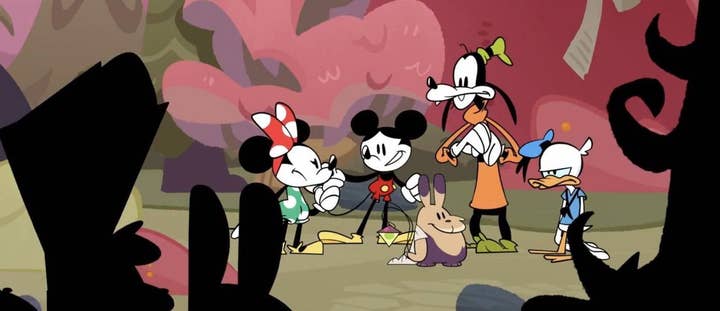Pitching to work on a well-known IP
CEO Aj Grand-Scrutton talks through the process that gave Dlala Studios access to established characters like Mickey Mouse and Battletoads
Preparing any sort of pitch can be nerve-wracking enough, whether it's for funding or a publishing deal. That's why the GamesIndustry.biz Academy has an entire family of guides dedicated to pitching.
But when you're pitching for the chance to develop a game around an established intellectual property – especially one that's already popular around the world – there can be an added level of intensity.
Fortunately, one studio that has been through this process multiple times has shared its secrets.
Speaking at last month's GI Live: London, Dlala Studios' CEO Aj Grand-Scrutton offered a step-by-step guide to the process of pitching to an IP holder – a process he and his team have used to secure deals to revive Rare classic Battletoads and work on a Mickey Mouse game (twice).
We've collated Grand-Scrutton's advice in one handy guide, covering:
- The two types of pitches
- The pre-pitch checklist
- Absorb everything you can on the IP
- Core goals of your pitch
- Which parts of the IP are you pitching for?
- Preparing your pitch
- Pitching your studio
- Show you understand the importance of the deal
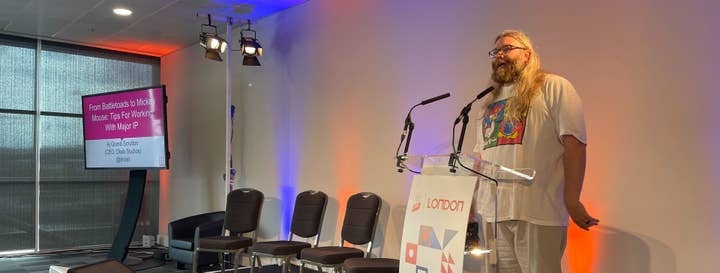
The two types of pitches
As a foundation for the rest of his talk, Grand-Scrutton broke down the two types of pitches: the 'request for proposal' or RFP, and the 'cold' pitch.
Request for proposal
An RFP is where either an IP holder will reach out to you as a developer (or your agent or representative, if you have one) and ask you to prepare a pitch for a specific brand.
There will normally be specific requirements and parts of the IP they wish for you to include in your pitch. This might include elements to avoid, or aspects they would like developers to modernise.
"Try to find out if IP holders are even willing to listen to pitches, [before] working on a 60-page deck"
They will also likely specify the format of proposal they're looking for, ranging from a one-page document to a full concept with game mock-ups. In Grand-Scrutton's experience, this is often a multi-stage process that's laid out in advance, with submission deadlines and details on when each step of the conversation will take place.
The cold pitch
Grand-Scrutton notes a cold pitch "isn't cold necessarily." Instead, he uses the term to refer to non-specified pitches where the developer may have reached out to the IP holder directly or heard through the grapevine that they are interested in pitches.
There is no specific brief before a cold pitch – no particular format, no details on what type of genre or experience the IP holder is looking for. The majority of pitches Dlala makes are cold, and what the bulk of Grand-Scrutton's talk is in preparation for.
The pre-pitch checklist
There are four things Grand-Scrutton advises studios to do before preparing their pitch for an IP holder.
- Make a list of IP that you feel you could do justice to
- Look into who the IP holders are
- Reach out and ask if they're taking pitches
- Only pitch for IP that you love
Using Google and Wikipedia are a "fine starting point" when investigating who you're even going to be pitching to, Grand-Scrutton says. But he adds that it can get complicated and that "you'll often find that the rights for the digital product might have been already licensed to someone else."
Finding a contact at these companies can be difficult, but even generic contacts or email addresses can be a start.
"Please don't harass people on LinkedIn -- no one wants to be harassed on LinkedIn," Grand-Scrutton says. "Try to find out if they're even willing to listen to pitches, [before] working on a 60-page deck."
Finally, Grand-Scrutton observes that many people target franchises that are successful or that they think are going to help them make money. And while that helps, it has to be an IP that is personally important to you. Being genuinely passionate about that IP will make the experience, and ultimately the game, better.
Absorb everything you can on the IP
Research is key to improving your chances of winning a deal with an IP holder. Your own knowledge as a fan of the franchise is not enough – it's a start, but you need to know more than you ever knew before if you want to convince IP holders that you're the right studio for the job.
"You need to be at least temporarily the Wikipedia for that IP," says Grand-Scrutton. "That doesn't mean you have to know everything, but it has to mean you've done your best to absorb all you can.
"Before pitching this to Disney, I went and I watched all the cartoons on Disney+, I read the comics, I've read the Bible-length '90-year History of Mickey Mouse.' I went back and played the old games, I went into the Disney fandom Wiki. I made sure that my passion for Mickey was supported by my knowledge of Mickey."
The reason for this level of research boils down to a simple question: can you live in this world for years of your life?
"Because that is what you will be doing," says Grand-Scrutton. "I pitched [Illusion Island] in October 2019, and it's not out yet – three years later. If you're going to do good IP stuff, this is the question you have to be willing to answer. And if the answer is 'no,' then I just wouldn't bother."
He adds that IP holders "deserve the respect of you honouring [their creation]" and that existing franchises have existing fanbases who have expectations for any product based on their IP of choice.
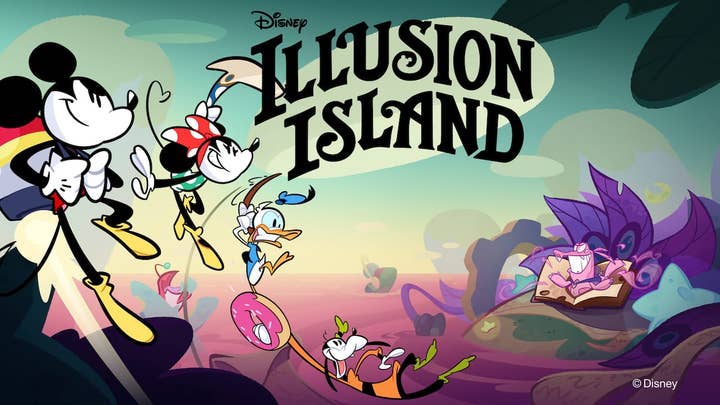
Core goals of your pitch
Grand-Scrutton said there are three key goals you need to accomplish with your pitch:
- Show an awesome idea
- Show an awesome team
- Show awesome knowledge of the IP
All three are important, but Grand-Scrutton placed a particular emphasis on the first goal.
"If you've got a weak game idea, then it doesn't matter how great all the rest of this pitch is because it's a weak game idea," he says. "This has got to be your foundational starting point. Make sure you're doing something awesome. It doesn't even have to be something new and completely innovative. If it's something super fun and awesome, it's a great foundational point."
Which part(s) of the IP are you pitching for?
Deciding exactly which aspects of an IP – whether it's a character, a story or a setting – that you're pitching around is vital.
Smaller franchises, or ones that have not existed for very long, are easier to pitch for because "you're basically pitching for the whole thing." But when you think about all the facets involved in the Star Wars universe or Marvel, you need to start being a lot more specific.
"Don't tell storytellers that you know how to write stories better than them"
Grand-Scrutton suggested a number of questions to ask yourself when deciding what to pitch for:
- Which characters?
- What locations? What is the setting which justifies the use of the world? Are you making a game set in a brand new world? Or an established one? Your pitch will also need to cover "how those locations get reflected in your game" and why your game idea is a good fit for this world.
- Where does it fit in the existing canonical timeline? Or is it something different?
The latter, says Grand-Scrutton, can be a dangerous question and he recommends that 99% of the time, developers should try to avoid pitching something that would be canonical.
"It's just risky because at that point you're then going to be involved with a lot of people who aren't involved normally," he explains, referring to the fact that everything in your game will need to align with all other past products in that universe, as well as those in the works – even in other media.
Instead, he recommends making things that are in extended or alternative universes. Insomniac Games, for example, has done a solid job of this with its Spider-Man and Miles Morales games.
Preparing your pitch
There are two key ways in which your pitch needs to make it clear how much you know and have researched about this IP: tone and theme. These two ideas need to be at the forefront of your entire presentation at all time.
Make sure you reflect the tone of the IP in how you're presenting the deck, and remember that the slides must always fit the brand. This can encompass everything from making sure you use the same colours the IP holder does when promoting its brand – and, if you can find them online, the same or at least similar fonts – to writing the text of your slides in a way that fits with the tone of the IP. All of this will help to demonstrate your knowledge of the franchise.
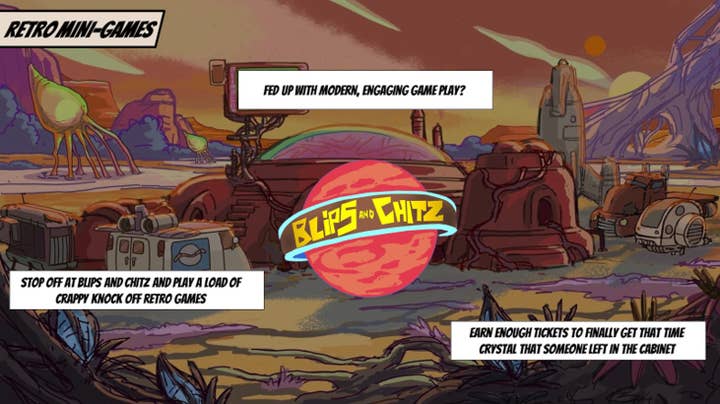
There are several areas your pitch needs to cover in order to convince IP holders to hand over the reins to their beloved brand.
Show your inspirations
One slide Grand-Scrutton recommends including in your deck is examples of your inspirations. This can be really useful when talking to non-games people as it gives them points of comparison. In fact, if the person you're presenting to knows nothing else about your deck, this single slide can help get across the core mechanics. It's also worth adding some popular games in there, Grand-Scrutton says.
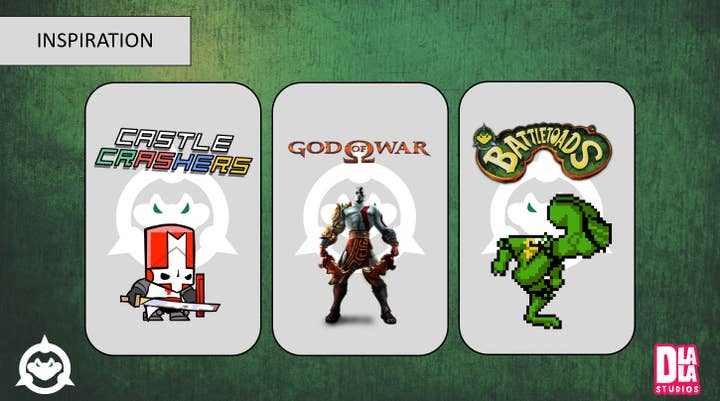
The above example is from the slide deck that helped Dlala secure the Battletoads deal.
"We knew we wanted side-scrolling combat, and we wanted it to be a playable cartoon, so Castle Crashes was a great reference," Grand-Scrutton explains. "We weren't making a AAA God of War-style game but what God of War did really well was fluidity. Even the older games, they felt very fluid, the experience and the action was fluid, they did setpieces. This was stuff we wanted in our Battletoads.
"Obviously it's a no-brainer if you're pitching for a Battletoads game, you mention Battletoads. If you're pitching for any IP, I would always recommend you put that IP as one of your inspirations. It sounds corny, but it is important. We also wanted to show which part of the franchise was the important one. We weren't making a new Battletoads Arcade game, we were making a new Battletoads."
Grand-Scrutton emphasises this slide should be tailored to your audience's understanding, perhaps more so than your actual inspirations.
"If your game is influenced by a quirky Japanese title that sold 10,000 copies in the UK, it's not going to be good enough to put on there – even if it is your biggest inspiration," he says. "The people signing off on this stuff want to see a game that they can type in and see the words ‘sold 500,000 copies.'
"I'm not telling you to lie. What I'm saying is make sure you try and find a way to root your truth in something that has had financial success, because let's be honest, a lot of the time that's all the people are looking for on the other end."
Discuss the story
Almost every game you pitch will have a narrative element, and it's important you discuss this in the original pitch, summarising the premise of the game in a single slide.
This is also a chance to demonstrate you understand your audience – not just the end users who will play the game, but also the people you're pitching to.
"If you're pitching to a visually-driven company, showing how you would achieve your vision of their art is important but expensive"
"For instance, when I pitched to Disney, I didn't claim for a second that I can tell stories better than Disney, because no one can," Grand-Scrutton says. "Instead, I said 'Here's a story in a concept but we want to work with you to really develop this.' If you're pitching for something that isn't necessarily a story-driven IP, then sure, you can show off your storytelling skills, but this [story slide] isn't about showing off, it's about the conceit for which the game sits in.
"Don't tell storytellers that you know how to write stories better than them, but give those people who aren't natural storytellers the faith that you can bring something to the IP."
Grand-Scrutton also encourages developers to ask whether they will be able to write the story with their own writers. That might not be decided during the pitch meeting, but it's worth broaching early.
Describe the visuals of your game
You need to convey what the finished game will look like – but Grand-Scrutton says to avoid saying it will recreate the visual quality of the property in question.
"That's very unlikely and you probably don't want it to, and they don't want it to," he explains.
He suggests making a simple slide to give an idea of the visual style, using reference images if you have them or drawing some new ones.
"You don't have to have bespoke art necessarily, but it will help at times," Grand-Scrutton adds. "If you're pitching to a very visually-driven company, being able to show how you would achieve your vision of their art is important, but it's expensive."
It's also worth including some concept art in, and a gameplay mock-up so you can better describe it to anyone in the room that isn't a games person.
Explain who the target audience is
Developers need to ask themselves, 'Who is the game for?' And there's one answer Grand-Scrutton says you need to avoid.
"Do not say 'Everyone'," he says. "It's a lie. You know you want everyone in the world to play it, but you're not making a game for everyone. If you demonstrate you know who the audience is and what part of that audience you're targeting, it makes you look good."
With the most popular, broader franchises, you need to be even more specific. Think about age brackets, or whether you're targeting people who enjoy the television shows vs the comics or books, or perhaps younger fans who prefer the cartoons. If you're pitching a Star Wars game, think about which Star Wars fans you're targeting.
Grand-Scrutton says: "I'm a big Star Wars fan but I'm not a Jar-Jar Binks fan, so if you've got a Jar-Jar Binks game, I won't play it. Have an understanding of who your audience is."

Why does your game need to be made now?
Developers should include a slide that explains why their pitched game should be made for today's market. Why is now the right time for you to develop this? You should also think about existing games based on this IP, and how yours will fill a need that has not been met yet.
Think about gaps in the market and on popular platforms for the type of title you want to make. PlayStation, for example, has enjoyed great success with Insomniac's Spider-Man games, and Grand-Scrutton suggests Xbox would love a similar title on its own platform.
"If no one's made a Battletoads game in 26 years, you have to explain why it makes sense to do one now"
Another consideration might be when you're pitching for a dormant IP, why should it get a revival?
"If no one's made a Battletoads game in 26 years, you have to explain why it makes sense to do one," Grand-Scrutton said. "When I pitched to Rare, I said I presumed a third of the original Battletoads audience were dead, a third of them probably haven't got time to play games because they have kids, and then, at most, we could probably target a third of that original audience. That's not a good opportunity. The opportunity was to re-engage some people, but focus on bringing Battletoads to a wider new audience. So why is the audience ready for a title like this?"
Thinking beyond the games market will also help identify opportunities. What's happening in pop culture and trends in general that shows there's a need for your game?
How does it help the IP?
This is perhaps one of the most important slides in your deck: explain to the IP holder how they and their property will benefit from your game.
Again, you need to think about who your audience is and what they can already do without you; Grand-Scrutton says he did not suggest Illusion Island would help sell Mickey Mouse toys, as Disney isn't exactly struggling in that department.
"The big thing for us with Battletoads, and to an extent with Mickey, is we're trying to bring a new audience in," he explained. "We're trying to invigorate brands that haven't necessarily connected with the gaming audience for a while."
For other pitches, Dlala has suggested a video game can help connect an audience with the core aspects of an IP, such as a comic, by onboarding them into the franchise.
"You are effectively sitting in a room asking the IP holder to give you their baby, right? So justify why it makes sense from their perspective."
Pitching your studio
Your pitch should also demonstrate why you are the right studio to make a video game based on the target IP. Grand-Scrutton emphasised the importance of conveying your team's strengths through your deck. For this he offered the following advice:
Don't be modest
"Straight out the bat, just put your biggest accomplishments there," Grand-Scrutton says. "Don't lie, but don't be modest – you are there to sell yourself."
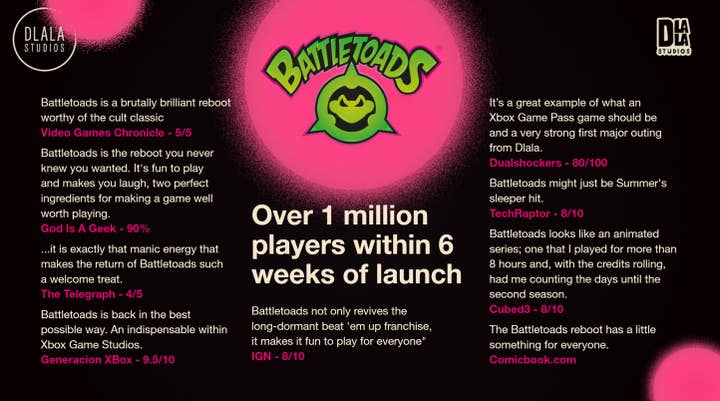
Show your strengths
Grand-Scrutton suggests slides showing the credits of key team members. He stresses this does not mean you undervalue the rest of your staff, but builds the IP holder's confidence in who's going to leading development.
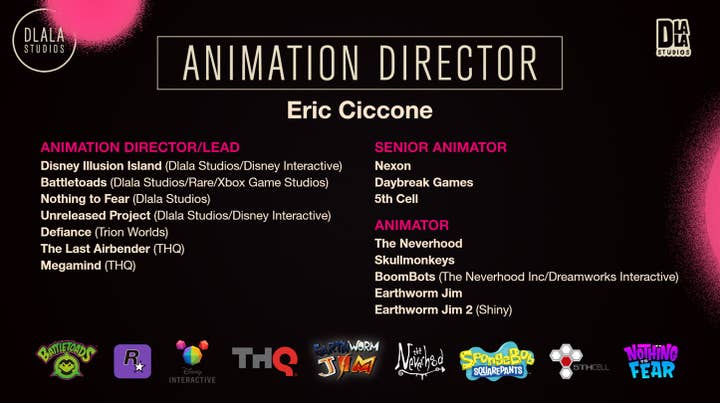
Show your specialties
An example slide points to how Dlala has extensive experience in hand-drawn 2D games, has worked with established franchises, and so on.

Show your combined experience
"Don't just include what the studio's done," Grand-Scrutton says. "Dlala has never made a SpongeBob, Star Wars, Aladdin or Merlin game -- but the people on our team have, so we put that in our deck. We don't lie about it, but it's better to lead with this and explain later."
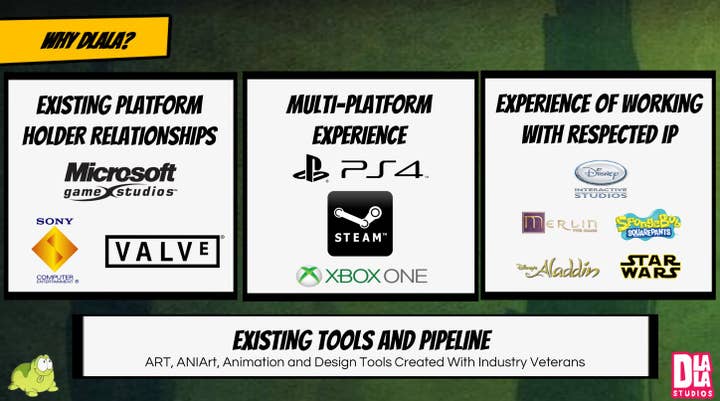
Keep it up to date
Grand-Scrutton says he has actually made three or four variations of every studio-centric slide in his deck, and he selects the one he's going to use depending on who he's pitching to.
Show that you understand the importance of the deal
Concluding his talk, there are two words Grand-Scrutton emphasised the importance of, ones that you need to demonstrate in order to secure the deal.
Respect
The most important word, he says, is respect. Show the IP holder how you will respect their brand, because that is what they will be most worried about.
"Make sure you are very sincere that you're not here to make a quick buck off the IP. You are here to give it love and care, treat it as if it's your own"
"Most developers here probably worked on original IP – think about somebody taking that and doing stuff with it that you don't have control of. It's probably terrifying, right? That's effectively what you're saying. I said to the Walt Disney Company, ‘Hey, I want to take your 96-year-old IP and do some stuff with it' – I had to show them I was going to respect Mickey & Friends. I always was, but they don't know that, so just make sure you demonstrate that.
"Make sure you are very sincere that you're not here to make a quick buck off the IP. You are here to give it love and care, treat it as if it's your own, and do something really awesome with it that maybe they can't do internally, and that's why you provide value."
Passion
While Grand-Scrutton acknowledges this can be a dirty word in some instances across the games industry, you need a genuine passion for the IP you're pitching – and you need to show the IP holder how much you love their brand. Again, he points to the abundance of Mickey Mouse merchandise in his office.
"When I pitched for Illusion Island, there was no one that left that room -- no one that left any room ever with me – that doesn't know how much I love Mickey. I mean, I'm a grown man so maybe I shouldn't love Mickey quite as much, but this is important.
"You're pitching for IP, show them how much you love it. And like I said at the start, only pitch for the IP you love. Only pitch for the stuff you're willing to absorb, that you're willing to live in, because especially as leaders, not everyone on your team is going to be that into the IP. Those people will be influenced and feel inspired if they see how much you love it. They'll feel like they're doing something special."
You can watch Grand-Scrutton's talk in full below:
More GamesIndustry.biz Academy guides on pitching
You can find all our pitching guides here, including:
